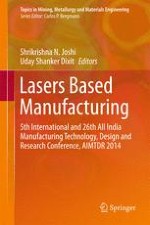2015 | OriginalPaper | Chapter
Studies on CO2 Laser Micromachining on PMMA to Fabricate Micro Channel for Microfluidic Applications
Authors : Rishi Kant, Ankur Gupta, S. Bhattacharya
Published in: Lasers Based Manufacturing
Publisher: Springer India
Activate our intelligent search to find suitable subject content or patents.
Select sections of text to find matching patents with Artificial Intelligence. powered by
Select sections of text to find additional relevant content using AI-assisted search. powered by
